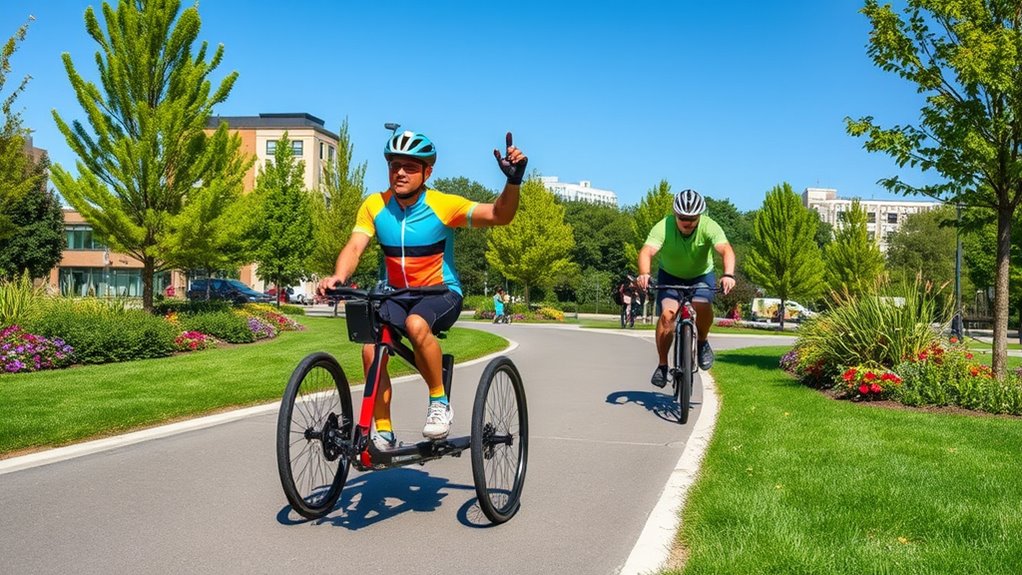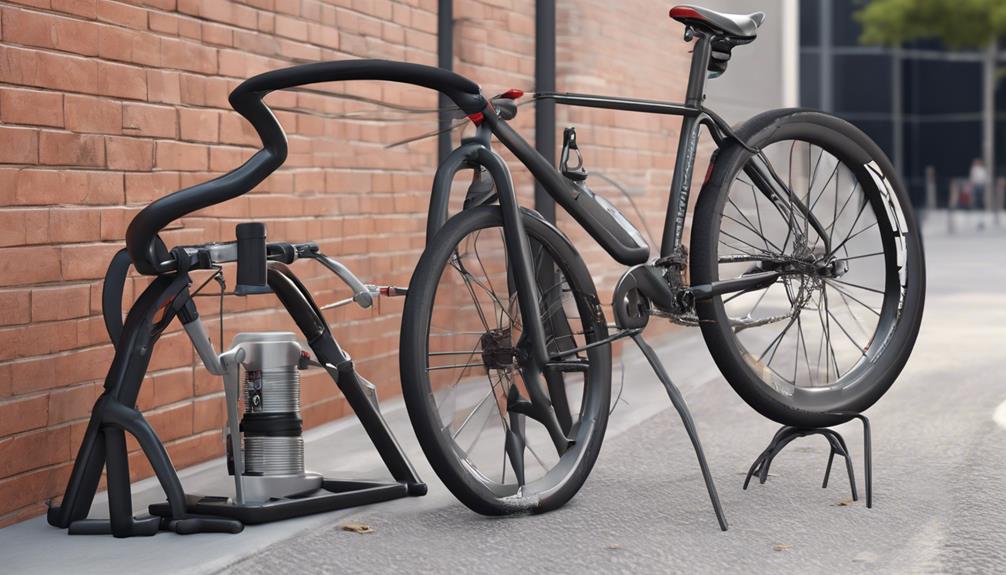Technology plays a crucial role in enhancing adaptive cycling by improving stability, safety, and maneuverability. Innovations like independent suspension, adjustable controls, and lightweight materials help you ride more confidently and comfortably. Advanced steering, sensor integration, and digital safety systems increase awareness and protection on diverse terrains. These tools support greater independence and participation. To discover how emerging tech continues to shape accessible cycling, explore the latest advancements transforming your experience.
Key Takeaways
- Advanced stability and maneuverability features improve safety and confidence for adaptive cyclists.
- Multi-motion and power assistance technologies expand mobility options and facilitate personalized riding experiences.
- Innovative steering, suspension, and safety systems enhance control, comfort, and environmental adaptability.
- Customizable components and ergonomic designs ensure better fit, comfort, and inclusivity for diverse users.
- Connectivity and smart safety features increase environmental awareness, ride security, and support for independent cycling.
Advancements in Stability and Maneuverability

Advancements in stability and maneuverability have profoundly transformed adaptive cycling, making rides safer and more accessible. Three-wheel designs replace traditional bikes, providing better balance and reducing the risk of falls. Independent suspension systems absorb shocks on rough terrain, smoothing out the ride. A low center of gravity in adaptive tricycles minimizes tipping during sharp turns, while wider wheelbases enhance lateral stability for riders with limited core strength. Anti-tip mechanisms further prevent backward or forward falls during starts and stops. These innovations give you more confidence on diverse surfaces and complex maneuvers. Understanding the contrast ratio of the design elements can help optimize visual cues for better spatial awareness and safety during rides. Moreover, incorporating innovative materials into frame construction can further improve durability and weight distribution, enhancing overall ride quality. Attention to ergonomic design ensures that the bike accommodates various physical needs, making adaptive cycling more inclusive. Incorporating advanced technology such as sensors and adaptive controls can further personalize riding experiences and improve safety features. Integrating community feedback into design improvements can lead to more personalized and effective adaptive cycling solutions. By focusing on stability, adaptive cycling becomes safer and more enjoyable, allowing riders to navigate confidently and independently in various environments.
Multi-Motion and Power Assistance Systems
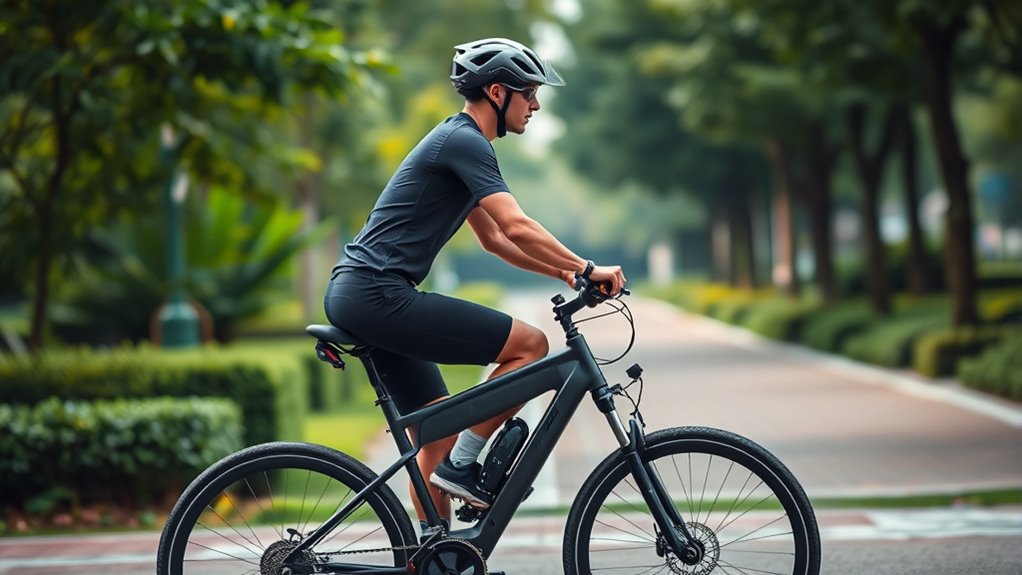
Multi-Motion and Power Assistance Systems considerably expand the capabilities of adaptive cycling by tailoring the ride to your specific mobility needs. With combined upper and lower limb propulsion, such as BerkelBike’s arm-leg drive trains, you can pedal even with limited lower-body strength. Automation technologies are increasingly integrated into assistive devices to improve functionality and user experience. Reciprocal leg movement mechanisms improve neuromuscular retraining and motor planning, while adjustable resistance settings match your strength and endurance. Customizable crank lengths optimize pedaling efficiency, and multi-gear configurations help you adapt to various terrains, reducing joint strain. Electric assistance features, like pedal-assist motors and throttle controls, amplify your effort during inclines or fatigue. Regenerative braking recharges batteries, and torque-sensing assist ensures smooth power delivery—all working together to enhance your control, comfort, and independence during each ride.
Innovations in Steering and Suspension Technologies
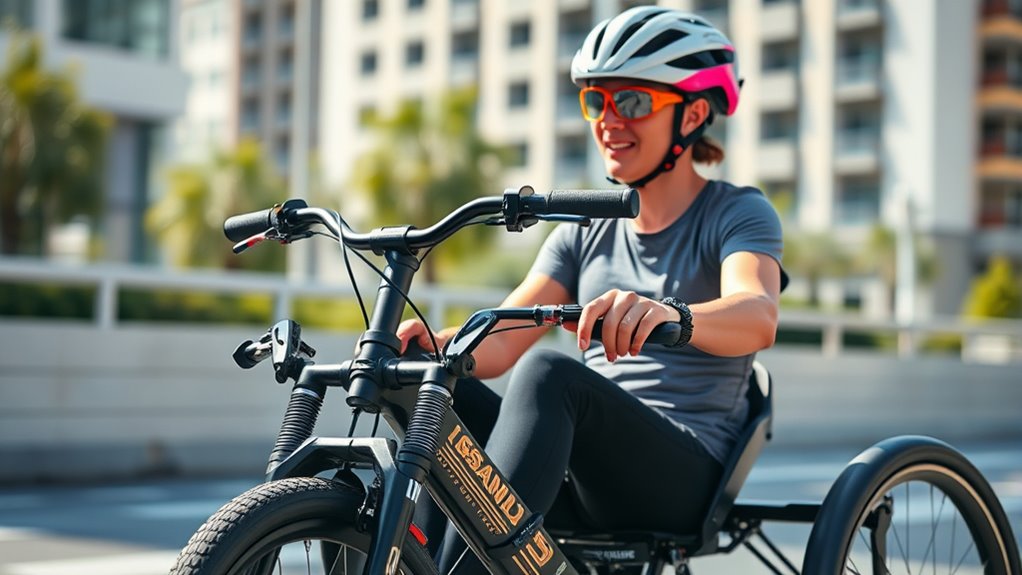
Innovations in steering and suspension technologies are transforming adaptive cycling by improving stability, maneuverability, and comfort. The Tiltahedron system in Triple Tread’s adaptive tricycles enhances cornering, giving you better control on turns.
Adaptive steering systems like EPS and SbW, inspired by vehicles, can reduce effort and fatigue, making steering easier. Customizable controls in handcycles help riders with limited arm movement, influencing future steering designs. Incorporating adaptive steering technologies can further optimize control and rider experience. Additionally, integrating user-centered design principles ensures that these systems meet the diverse needs of riders, promoting inclusivity.
Suspension innovations, such as independent suspension, smooth out uneven surfaces, providing a more comfortable ride. Proper suspension maintains balance and reduces strain, especially on challenging terrains. These advancements are driven by ongoing cybersecurity efforts to safeguard sensitive data related to device configurations and user profiles.
When combined, advanced steering and suspension boost stability, improve terrain adaptability, and lessen rider fatigue. These technological advances make cycling more accessible, safe, and enjoyable for riders of all abilities. Regular maintenance of these components ensures consistent performance and longevity.
Customization and Personalization of Adaptive Cycles

Customization and personalization are essential in making adaptive cycles truly suited to each rider’s unique needs. Modular frame designs let you adjust for rider height, weight, and posture, while material choices like lightweight alloys or reinforced steel guarantee durability and easy handling. You can select recumbent or upright configurations based on mobility preferences, and three- or four-wheel setups provide extra stability for balance challenges. Expandable seating accommodates growth or postural changes, especially for pediatric users. User-specific control systems, such as hand-operated brakes, gear shifters, and adaptive pedals, enhance comfort and functionality. Ensuring safety and comfort is vital for a positive adaptive cycling experience. Incorporating adaptive technology can further customize the riding experience to meet individual needs and preferences. Additionally, integrating ergonomic design principles ensures that each component supports proper posture and reduces fatigue during extended rides. Emphasizing individual customization allows for a more inclusive and effective cycling experience tailored to each rider. A comprehensive understanding of adaptive cycling can inform better design choices that enhance user satisfaction and safety.
Enhancing Safety With Digital and Sensor Technologies

Digital and sensor technologies are transforming adaptive cycling by actively increasing safety and awareness on the road. AI-powered alert systems detect approaching vehicles and notify you visually, giving you more time to react. Ford tuning techniques can optimize the performance of these digital systems to improve safety. Additionally, incorporating eye patch benefits helps in maintaining healthy skin, which can be beneficial for cyclists exposed to outdoor elements. Advances in sensor integration further enhance real-time environmental awareness and responsiveness.
Impact of Technology on User Independence and Confidence

Technological advances in adaptive cycling considerably boost your confidence and sense of achievement. By enabling you to ride independently or with minimal help, these innovations foster a sense of autonomy. Using adaptive bikes like handcycles or tandem cycles, you can successfully participate in activities that once seemed out of reach, strengthening your self-assurance. Customizable features tailor the cycling experience to your unique needs and goals, making every ride more enjoyable and meaningful. The advanced design of adaptive bikes, emphasizing stability and ease of use, helps you build confidence over time. For example, performance upgrades such as lightweight components or enhanced steering mechanisms can further improve handling and comfort, contributing to increased confidence. As you master riding on your own, you experience increased well-being and a greater sense that you can overcome challenges, empowering you to enjoy cycling with newfound independence.
Challenges and Opportunities in Making Adaptive Cycling Accessible

Making adaptive cycling accessible involves overcoming several design and infrastructure challenges that can limit participation.
Trails must be at least 40 to 42 inches wide to accommodate three-wheeled adaptive cycles, and bridges should match these widths.
Excessive camber can cause bikes to flip or roll, so trails need proper control measures like wider bench cuts and berms.
Safety is critical; trails shouldn’t have large obstacles or unstable features that could obstruct riders.
Environmental adaptations, such as stable surfaces and easy access points, are essential for diverse needs.
Barriers like limited supportive environments, regulatory restrictions, inadequate parking, and social stigma hinder participation.
However, opportunities like diversified equipment, community engagement, and technological innovations can address these issues, making adaptive cycling more inclusive and accessible.
Future Perspectives in Adaptive Cycling Technology
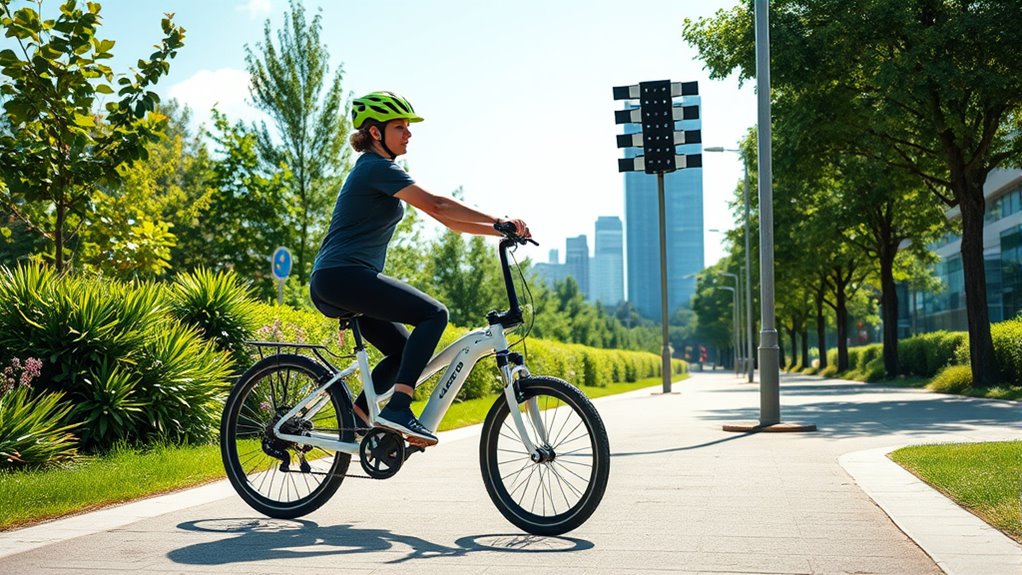
Looking ahead, innovations in adaptive cycling technology promise to transform how you experience and access cycling. Electric assist systems will make riding easier and more accessible for riders with diverse capabilities.
Future adaptive cycling innovations will make riding easier, more accessible, and tailored to diverse needs.
Intelligent suspension will automatically adapt to terrain, enhancing comfort and stability. Lightweight aerogels in bike frames will provide superior insulation, allowing you to ride comfortably in various weather conditions. New flexible frame materials will reduce vibrations and fatigue, making rides smoother.
Connectivity will advance, integrating GPS and smart city features for safer navigation. Customizable designs, ergonomic seating, and adjustable handles will personalize your bike to fit your needs.
Enhanced motor efficiency, smart safety features, and health-tracking technology will improve your riding experience, making adaptive cycling more accessible, enjoyable, and health-promoting in the future.
Frequently Asked Questions
How Do Adaptive Cycling Technologies Improve Long-Term User Health Outcomes?
You might wonder how adaptive cycling technologies boost your long-term health. They help by increasing your cardiovascular fitness, building muscle strength, and reducing joint stress through low-impact movement.
These innovations also support mental health by enhancing mood, reducing stress, and promoting social engagement. Over time, they improve your overall quality of life, boost confidence, and make exercise more accessible, ensuring you stay active and healthier longer.
What Are the Costs Associated With Integrating Advanced Tech Into Adaptive Cycles?
When it comes to integrating advanced tech into adaptive cycles, you’re really opening a can of worms. You’ll face high initial costs for custom engineering, durable materials, and precision fabrication.
Adding motor assistance, smart sensors, and modular interfaces bumps up expenses further. Plus, ongoing maintenance like battery replacements and specialized repairs can add up.
While these investments improve performance, they require careful budgeting to balance innovation with affordability.
How Do Specific Disabilities Influence the Choice of Adaptive Cycling Technology?
You need to contemplate how your specific disability affects your cycling needs. For lower body impairments, tricycles or recumbent bikes offer stability and comfort. Power-assisted e-cycles help with strength.
If you have upper limb limitations, handcycles and adapted handlebars improve control. Neurological conditions may require semi-recumbent bikes or customizable resistance.
Visual impairments benefit from tandem setups and auditory cues. Selecting the right tech ensures safer, more enjoyable rides tailored to your abilities.
What Role Do Community Programs Play in Promoting Adaptive Cycling Adoption?
Community programs play a powerful part in promoting adaptive cycling adoption by providing accessible equipment, encouraging inclusive involvement, and creating connections. They foster friendly environments where you can find support, share stories, and strengthen skills.
Through social rides, supportive staff, and shared experiences, these programs inspire confidence and cultivate community, making adaptive cycling more approachable.
Your participation can push past barriers, bring people together, and promote active, inclusive adventure for all.
Are There Environmental Sustainability Considerations in Developing New Adaptive Cycling Tech?
You should consider environmental sustainability when developing new adaptive cycling tech. Focus on creating energy-efficient models that reduce reliance on external power sources, like self-generating electric bikes.
Use lightweight, durable materials to extend lifespan and minimize waste. Incorporate renewable energy options and innovative designs that lower carbon emissions.
Conclusion
In embracing these technological leaps, you’re opening a future where adaptive cycling becomes unstoppable, transforming lives faster than you can imagine. With every innovation, you’ll experience freedom so profound, it’s like soaring beyond limits you once thought impossible. Technology isn’t just enhancing adaptive cycling — it’s revolutionizing your entire world, making independence feel effortless and confidence skyrocket to legendary heights. Get ready to ride into a future where anything is possible, and barriers vanish into thin air.
